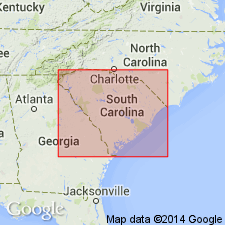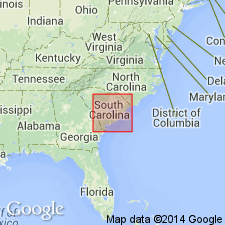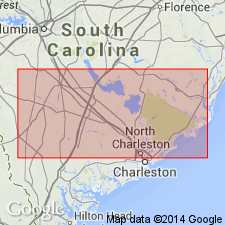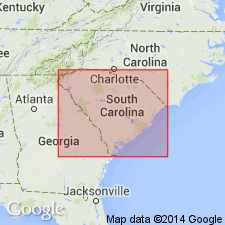
- Usage in publication:
-
- Caw Caw shales and marls
- Modifications:
-
- Named
- Dominant lithology:
-
- Shale
- Marl
- AAPG geologic province:
-
- Atlantic Coast basin
Summary:
Warley Hill phase of earlier reports is here divided into Upper or Warley Hill marl and Lower or Caw Caw shales and marls. The Lower Warley Hill formation lithologically represents a transition from Congaree shales [below] to later marls and comprises both shales and marls, often intergrading. Faunally they are distinctly characterized by first appearance of OSTREA SELLAEFORMIS in SC and by abundant association of PTEROPSIS LAPIDOSA. Succeeding a coarse glauconitic sand, a pea-green clay, now in the form of a slightly laminated shale, occupied the shoal areas, while pale yellow-green and gray marls formed in the deeper waters, and intergraded with the shale along their dividing zone. In some areas an irregular deposit of yellow to gray marls extended over the basal pea-green shales, but along the shoal areas renewed silting covered this broken bed of marl with a very fossiliferous pale yellow-green shale, in which casts of a large VENERICARDIA PLANICOSTA, PTEROPSIS LAPIDOSA, OSTREA SELLAEFORMIS are found. At Kennedy's Scarp on Tinkers Creek this pea-green shale encloses a matted mass of soft shells at base of the scarp. Some erosion, solution, or other degradation of the top shales of Lower Warley Hill phase occurred preliminary to deposition of Upper Warley Hill series. At some localities the Upper Warley Hill is represented by a bed of dark-gray, slightly glauconitic, fine-grained laminated shale. It is coarser grained near its base and includes rounded gravel. Its greatest thickness is approximately 24 ft. The most extensive area of Upper Warley Hill phase exposes the characteristic Warley Hill glauconitic marl, which at Warley Hill may be seen resting on the slightly irregular surface of Lower Warley Hill series. It is exposed along Santee Valley as far down as Pinckney's Landing, and along Edisto River from Branchville to Sullivan's Bridge. Its greatest observed thickness does not exceed 25 ft. The Warley Hill marl is of a dirty gray-green color, compact, hard, and very harsh to the touch. The latter feature is accentuated by the large angular grains of glauconite. At one locality small semispherical crystals of wavellite appear to have been derived from the weathered glauconitic mass.
Source: GNU records (USGS DDS-6; Reston GNULEX).

- Usage in publication:
-
- Caw Caw shales†
- Modifications:
-
- Abandoned
- AAPG geologic province:
-
- Atlantic Coast basin
Summary:
Caw Caw shales of Sloan (1908) are simply local development of lower McBean formation, a marine deposit of Claiborne age.
Source: GNU records (USGS DDS-6; Reston GNULEX).

- Usage in publication:
-
- Caw Caw Member
- Modifications:
-
- Reinstated
- AAPG geologic province:
-
- Atlantic Coast basin
Summary:
Caw Caw shales of Sloan (1908) reinstated as Caw Caw Member of Santee Limestone. Strata was correlated with McBean Formation of GA by Cooke (1936), but these authors state that they bear no resemblance to McBean. Therefore, McBean Formation is restricted from this area. Though no type section was designated by Sloan, authors consider section OR-5 along Caw Caw Swamp to be typical. Middle Eocene age of Caw Caw based on megafauna.
Source: GNU records (USGS DDS-6; Reston GNULEX).

- Usage in publication:
-
- Caw Caw
- Modifications:
-
- Not used
- AAPG geologic province:
-
- Atlantic Coast basin
Summary:
Authors state that Sloan (1908) miscorrelated the beds along Caw Caw Swamp (mapped by Nystrom (1987) as McBean Formation) with beds at the Warley Hill type locality that are now recognized as the Congaree Formation. McBean Formation has been used for decades in SC and authors follow that usage. Authors argue that beds at Caw Caw Swamp are lithologically distinct from the Santee Limestone, but allow that fossil assemblages do clearly correlate with the Santee.
Source: GNU records (USGS DDS-6; Reston GNULEX).
For more information, please contact Nancy Stamm, Geologic Names Committee Secretary.
Asterisk (*) indicates published by U.S. Geological Survey authors.
"No current usage" (†) implies that a name has been abandoned or has fallen into disuse. Former usage and, if known, replacement name given in parentheses ( ).
Slash (/) indicates name conflicts with nomenclatural guidelines (CSN, 1933; ACSN, 1961, 1970; NACSN, 1983, 2005, 2021). May be explained within brackets ([ ]).

